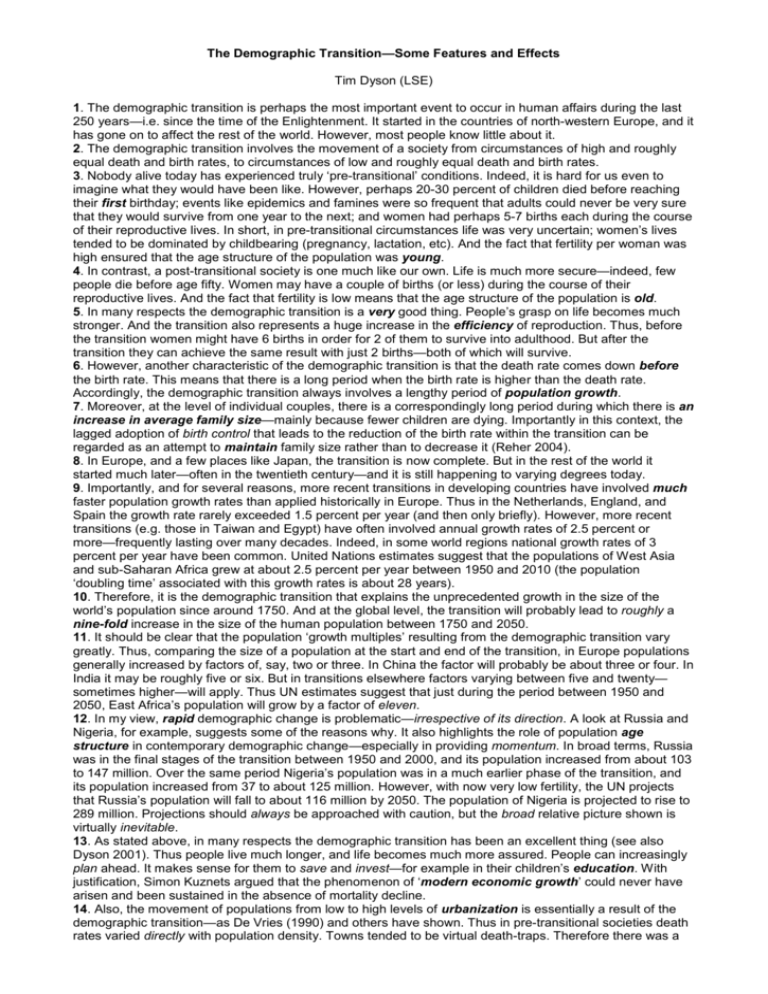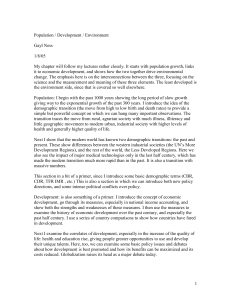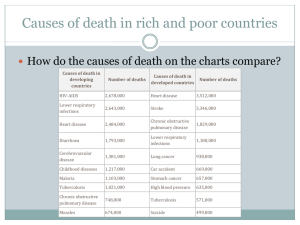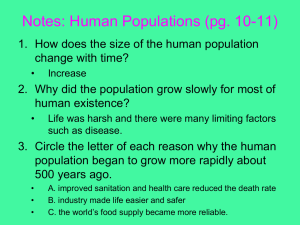Summary Tim Dyson
advertisement

The Demographic Transition—Some Features and Effects Tim Dyson (LSE) 1. The demographic transition is perhaps the most important event to occur in human affairs during the last 250 years—i.e. since the time of the Enlightenment. It started in the countries of north-western Europe, and it has gone on to affect the rest of the world. However, most people know little about it. 2. The demographic transition involves the movement of a society from circumstances of high and roughly equal death and birth rates, to circumstances of low and roughly equal death and birth rates. 3. Nobody alive today has experienced truly ‘pre-transitional’ conditions. Indeed, it is hard for us even to imagine what they would have been like. However, perhaps 20-30 percent of children died before reaching their first birthday; events like epidemics and famines were so frequent that adults could never be very sure that they would survive from one year to the next; and women had perhaps 5-7 births each during the course of their reproductive lives. In short, in pre-transitional circumstances life was very uncertain; women’s lives tended to be dominated by childbearing (pregnancy, lactation, etc). And the fact that fertility per woman was high ensured that the age structure of the population was young. 4. In contrast, a post-transitional society is one much like our own. Life is much more secure—indeed, few people die before age fifty. Women may have a couple of births (or less) during the course of their reproductive lives. And the fact that fertility is low means that the age structure of the population is old. 5. In many respects the demographic transition is a very good thing. People’s grasp on life becomes much stronger. And the transition also represents a huge increase in the efficiency of reproduction. Thus, before the transition women might have 6 births in order for 2 of them to survive into adulthood. But after the transition they can achieve the same result with just 2 births—both of which will survive. 6. However, another characteristic of the demographic transition is that the death rate comes down before the birth rate. This means that there is a long period when the birth rate is higher than the death rate. Accordingly, the demographic transition always involves a lengthy period of population growth. 7. Moreover, at the level of individual couples, there is a correspondingly long period during which there is an increase in average family size—mainly because fewer children are dying. Importantly in this context, the lagged adoption of birth control that leads to the reduction of the birth rate within the transition can be regarded as an attempt to maintain family size rather than to decrease it (Reher 2004). 8. In Europe, and a few places like Japan, the transition is now complete. But in the rest of the world it started much later—often in the twentieth century—and it is still happening to varying degrees today. 9. Importantly, and for several reasons, more recent transitions in developing countries have involved much faster population growth rates than applied historically in Europe. Thus in the Netherlands, England, and Spain the growth rate rarely exceeded 1.5 percent per year (and then only briefly). However, more recent transitions (e.g. those in Taiwan and Egypt) have often involved annual growth rates of 2.5 percent or more—frequently lasting over many decades. Indeed, in some world regions national growth rates of 3 percent per year have been common. United Nations estimates suggest that the populations of West Asia and sub-Saharan Africa grew at about 2.5 percent per year between 1950 and 2010 (the population ‘doubling time’ associated with this growth rates is about 28 years). 10. Therefore, it is the demographic transition that explains the unprecedented growth in the size of the world’s population since around 1750. And at the global level, the transition will probably lead to roughly a nine-fold increase in the size of the human population between 1750 and 2050. 11. It should be clear that the population ‘growth multiples’ resulting from the demographic transition vary greatly. Thus, comparing the size of a population at the start and end of the transition, in Europe populations generally increased by factors of, say, two or three. In China the factor will probably be about three or four. In India it may be roughly five or six. But in transitions elsewhere factors varying between five and twenty— sometimes higher—will apply. Thus UN estimates suggest that just during the period between 1950 and 2050, East Africa’s population will grow by a factor of eleven. 12. In my view, rapid demographic change is problematic—irrespective of its direction. A look at Russia and Nigeria, for example, suggests some of the reasons why. It also highlights the role of population age structure in contemporary demographic change—especially in providing momentum. In broad terms, Russia was in the final stages of the transition between 1950 and 2000, and its population increased from about 103 to 147 million. Over the same period Nigeria’s population was in a much earlier phase of the transition, and its population increased from 37 to about 125 million. However, with now very low fertility, the UN projects that Russia’s population will fall to about 116 million by 2050. The population of Nigeria is projected to rise to 289 million. Projections should always be approached with caution, but the broad relative picture shown is virtually inevitable. 13. As stated above, in many respects the demographic transition has been an excellent thing (see also Dyson 2001). Thus people live much longer, and life becomes much more assured. People can increasingly plan ahead. It makes sense for them to save and invest—for example in their children’s education. With justification, Simon Kuznets argued that the phenomenon of ‘modern economic growth’ could never have arisen and been sustained in the absence of mortality decline. 14. Also, the movement of populations from low to high levels of urbanization is essentially a result of the demographic transition—as De Vries (1990) and others have shown. Thus in pre-transitional societies death rates varied directly with population density. Towns tended to be virtual death-traps. Therefore there was a ceiling (i.e. a limit ) on how ‘urban’ any society could become. Interestingly, at about 30 percent urban, the Netherlands was probably the most urbanized country in the world in 1750. However, the attainment of a much higher level of urbanization requires the lifting of the ceiling—and this happens only as a result of mortality decline in urban areas. Consequently, urban natural increase and urbanization become possible— really for the first time. The death and birth rates available for urban and rural areas of Sweden provide a good—and extremely rare—illustration of the process. 15. It has also been argued that the movement of societies from autocratic to democratic forms of government—essentially, the process of democratization—is ultimately an outcome of the demographic transition (Dyson 2001). Thus in pre-transitional circumstances a country’s population is distributed diffusely. And a very large proportion of the population consists of children. However, the demographic transition greatly increases, concentrates, and (eventually) ages the population—and in these circumstances political power is eventually likely to become much more diffused in society. Moreover, the resulting increase in population size means that representative democracy, with political parties, tends to supplant the ideal of direct participatory democracy. 16. Also, there are strong reasons to believe that the processes of the transition have underpinned much of the reduction in gender differentiation that has taken place in demographically advanced societies (see Davis and van den Oever 1982). Consider, for example, that in a pre-transitional society as many as threequarters of all women aged 15-49 may be either pregnant or lactating at any one time. However, as the demographic transition proceeds so childbearing comes to constitute a much smaller fraction of women’s now much longer lives. Consequently the livelihoods of women gradually become less tied to concerns of the domestic domain. Interestingly, there are reasons to think that the consequent reduction in gender differentiation has been asymmetrical—i.e. it is women’s lives that have become more like those of men, rather than the reverse. 17. Yet the demographic transition also has its problematic side. For example, the rapid population growth rates and high ‘growth multiples’ that have characterized recent transitions of some developing countries have raised significant developmental challenges. This side of the unprecedented population growth that has resulted from the demographic transition can be illustrated briefly in three ways. First—and after a long period of agnosticism on the subject—the weight of current thinking among economists who study the issue is expressed well in Birdsall and Sinding’s statements that ‘rapid population growth is found to have exercised a quantitatively important negative impact on the pace of aggregate economic growth in developing countries’ and ‘rapid fertility decline is found to make a quantitatively relevant contribution to reducing the incidence and severity of poverty’ (2001: 6). Second, rapid urban growth is often seen as a problem. The main factor behind rapid urban growth in many poor countries today is rapid population growth. But as Preston has observed: ‘Oddly, family planning services are rarely seen as a candidate for slowing urban growth’ (Preston 1979: 210-11). Third, population growth exerts an upward effect on CO2 emissions. This effect is much bigger in rich countries, because of their much higher levels of per capita emissions. Illustrative calculations using the UN’s population projections suggest that projected demographic growth in South-central Asia between 2000 and 2050 will raise global emissions by about 931 million tons; but projected growth in North America will raise global CO2 emissions by almost 2.5 billion tons (see Dyson 2005: 137-38). 18. In conclusion: Population matters! The demographic transition has indeed been a good thing. But it also represents a period of destabilization—at both the household and the national levels. The provision of safe, effective, and affordable contraception is the main way of minimizing this destabilization—something which in some developing countries has been considerable. Contraception provides people with choice. And all the evidence is that, given the possibility of making the choice, then women and men eventually decide to take it. [Note: The author is currently writing a book on the demographic transition as part of a Research Fellowship funded by the UK Economic and Social Research Council. This presentation draws heavily from Dyson, T. (2001) ‘A partial theory of world development: The neglected role of the demographic transition in the shaping of modern society’, International Journal of Population Geography 7(2): 67-90. Anyone interested in the transition should also see Chesnais, J-C. (1992) The Demographic Transition, Oxford University Press. The population figures used above are taken mostly from the United Nations Population Division website. It is well worth a visit. Other sources cited are: Birdsall N. and S. Sinding ‘How and why population matters’, in N. Birdsall, A. Kelley and S. Sinding (eds.) (2001) Population Matters—Demographic Change, Economic Growth, and Poverty in the Developing World, Oxford University Press; Davis K. and P. van den Oever (1982) ‘Demographic foundations of new sex roles’, Population and Development Review 8(3): 495-511; De Vries, J. (1990) ‘Problems in the measurement, description, and analysis of historical urbanisation’, in A. van der Woude, A. Hayami and J. de Vries (eds.) Urbanisation in History, Oxford University Press; Dyson, T. ‘On development, demography and climate change’, Population and Environment 27(2):117-244; Preston S. ‘Urban growth in developing countries: A demographic reappraisal’, Population and Development Review 5(2): 195-215; Reher, D. ‘The demographic transition revisited as a global process’, Population, Space and Place 10(1): 1941] 2








